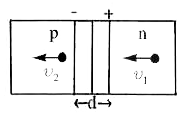A potential barrier of 0.50 V exists across a p-n junction.
An electron with a speed of 5.0×105 m/s approaches the p-n junction from the n-side. With what speed will it enter the p-side ? Solution in Telugu

Suppose the electron has a speed v1, when it enters the depletion layer and v2, when it comes out of it. As the potential energy increases by e×0.50V, from the principle of conservation of energy.
12mυ21=e×0.50+12mυ22
12(9.1×10−31)(5×105)2
=1.6×10−19×0.5+12×9.1×10−31×υ22
Solving this, υ2=2.7×105m/s
Topper's Solved these Questions
- SEMICONDUCTOR DEVICESBook:AAKASH SERIESChapter:SEMICONDUCTOR DEVICESExercise:EXERCISE -I (ENERGY BANDS AND CLASSIFICATION OF SOLIDS )
Explore 43 Videos
- SEMICONDUCTOR DEVICESBook:AAKASH SERIESChapter:SEMICONDUCTOR DEVICESExercise:EXERCISE -I (P-N JUNCTION DIODE)
Explore 35 Videos
- SEMICONDUCTOR DEVICESBook:AAKASH SERIESChapter:SEMICONDUCTOR DEVICESExercise:Problems (LEVEL-II)
Explore 7 Videos
- RAY OPTICSBook:AAKASH SERIESChapter:RAY OPTICSExercise:PROBLEMS ( LEVEL-II)
Explore 50 Videos
- UNITS AND MEASUREMENTBook:AAKASH SERIESChapter:UNITS AND MEASUREMENTExercise:PRACTICE EXERCISE
Explore 45 Videos
Similar Questions
Carbon, silicon and germanium have four valence electrons each. These are characterised by valence and conduction bands separated by energy band gap respectively equal to (Eg)c,(Eg)Si and (Eg)Ge .Which of the following statements is true ?
(a) (Eg)Si<(Eg)Ge<(Eg)C
(b) (Eg)C<(Eg)Ge>(Eg)Si
(c ) (Eg)C>(Eg)SI>(Eg)Ge
(d) (Eg)C=(Eg)Si=(Eg)Ge
View SolutionThe neutral region formed at P-n junction due to recombination of electrons and holes is
View SolutionA n-type silicon sample of width 4×10−3m, thickness 25×10−5m and length 6×10−2m carries a current of 4.8 mA when the voltage is applied across the length of the sample. If the free electron density is 1022m−3, then find how much time does it take for the electrons to travel the full length of the sample? Given that charge on an electron e=1.6×10−19C
View SolutionTwo plane mirrors are combined to each other such that one is in y-z plane and the other is in X-z plane. A ray of light travelling along a vector ˆi+ˆi+ˆk is incident on the first mirror. Find the unit vector in the direction of emergent ray after successive reflections through both the mirrors.
View SolutionThe ratio of S.I. unit of universal gravitational constant to C.G.S. unit is
View SolutionA potential barrier of 0.50V exists across a p-n junction.(a) If the depletion region is 5.0×10−7m wide,what is the intensity of the electric field in this region?(b) An electron with speed5.0×105ms−1approaches the p-n junction form the n-side.With what speed will it enter the p-side?
View SolutionA potential barrier of 0.4V exists across a p-n junction. If the depletion region is 4.0xx10^(-7)m wide, what is the intensity of the electric field in this region? If an electron with speed 4.5xx10^(5)m//s approaches the p-n junction from the n-side, find the speed with which it will enter the p-side.
View SolutionA potential barrier of 0.60V exixts across a p-n junction. If the depletion region is 6.0×10−7m wide, what is the intensity of the electric field in this region. An electrin with speed 5.0×105ms−1 approaches the p-n junction from the n-side, with what speed will it enter p-side.
View SolutionA potential barrier of 0.7V exists across a p-n junction If the depletion layer is 7.0xx10^(-7)m thick, what is the intensity of the electric filed in this region? If an electron is approaching the p-n junction from the n-side with a speed 6.0xx10^(5)ms^(-1) , determine the speed with which it enters the p-side of p-n junction.
View SolutionA potential barrier of 0.3V exists across a p-n junction. (a) if the depletion region is 1mum width. What is the intensity of elctric field in this region ? (b) An electron with speed 5xx10^(5)m//sec approaches this p-n junction from n -side, what will be its speed on entering the p -side?
View SolutionA potential barrier V volts exists across a P−N junction. The thickness of the depletion region is 'd'. An electron with velocity 'v' approches P−N junction from N-side. The velocity of the electron acrossing the junction is.
View SolutionIf an electron approaches the p-n junction from the n-side with a speed of 5×105ms−1 ,with what speed will it enter the p-side?
View SolutionIn a p-n junction, the thickness of depletion region is 2xx10^(-7)m and potential barrier across the junction is 0.20 V (a) What will be the intensity of electric field in this region ? (b) if an electron, from n-side approaches the p-n junction with speed 5xx10^(5) m//s . then with what speed it will enter the p-side ?
View SolutionA potential barrier of 0.3 V exists across a p-n junction. An electron with speed 5×105 m/s approaches this p-n junction from n-side, what will be its speed on entering the p-side?
View SolutionA potential barrier of 0.50V exists across a p-n junction.(a) If the depletion region is 5.0×10−7m wide,what is the intensity of the electric field in this region?(b) An electron with speed5.0×105ms−1approaches the p-n junction form the n-side.With what speed will it enter the p-side?
View Solution

